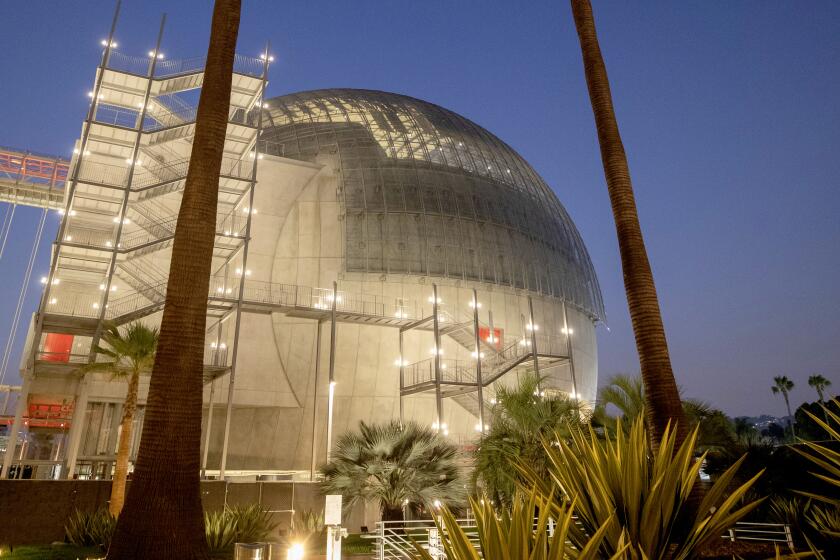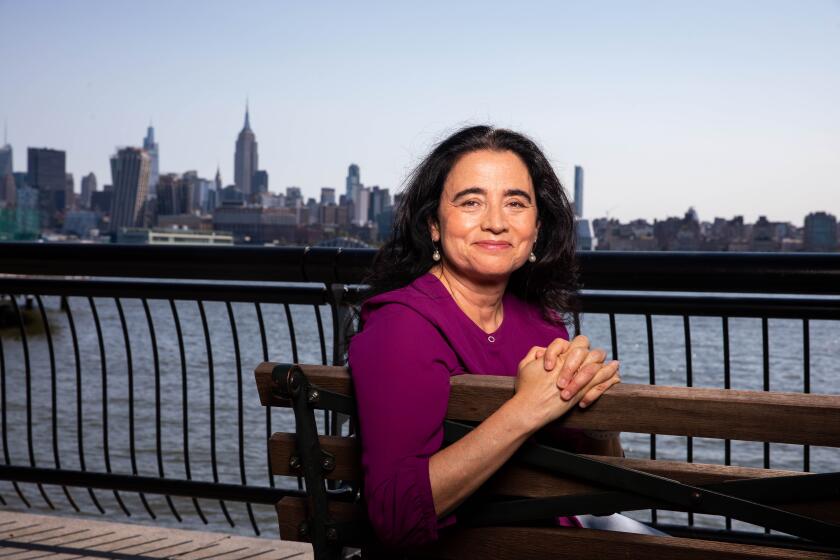LACMA erred big-time in unloading the May Co. building. Academy Museum shows why
- Share via
During a preview walk-through of the new Academy Museum of Motion Pictures last summer, two features of the ambitious project became crystal clear. One was impressive, the other demoralizing.
On the impressive side, the adaptive reuse of the 1939 May Co. department store, which sat mostly empty and unused since the once prosperous retail emporium went belly up more than a quarter-century ago, has been smartly executed, inside and out. It could well turn out to be a model for what should happen more often in a city known for its enthusiasm for tearing down historic structures and building anew from scratch.
Dispiriting, on the other hand, is the project’s confirmation that its next-door neighbor, the Los Angeles County Museum of Art, made a terrible mistake in giving up the building, which it had acquired for a song in 1994. As movies are, for me, a pleasurable pastime but not a main attraction, I left the tour thinking: lucky academy, and what a loss for LACMA.
The displays at the Academy Museum were yet to be installed, save for a few flashing screens and that giant mechanical shark from “Jaws,” the blockbuster 1975 cinematic scream-fest, now oddly suspended over the gaping maw of an escalator stairwell. Extensive structural work inside the building was long-since complete, and the interior floor plan was clear.
Column: L.A.’s new film museum was plagued by delays. Why that turned out to be a very good thing
If the Academy Museum had miraculously hit its original 2017 opening date, it would have been a far less interesting or important place.
A sensible layout of planned displays unfurled, floor by floor, all awaiting the imminent installation of artifacts, movie clips and thematic exhibitions on the history and aesthetics of filmmaking. (Various talented architects have been involved in the design, including Renzo Piano Building Workshop, SPF:architects, Kulapat Yantrasast’s WHY and Gensler.) There was little to see during the hard-hat tour except for the building itself and all that diligently refurbished space — 250,000 square feet of it, not counting the giant spherical theater stuck on out back in a former parking lot.
That pulled me up short. The magnitude of LACMA’s forfeiture was unexpectedly emphasized.
When the art museum bought the May Co. building, the general assumption was that someday it would be transformed into greatly expanded gallery exhibition space. Now, it’s easy to see why that didn’t happen.
Spatial flexibility was limited. Support columns are permanent.
Ceilings, especially above the ground floor, are on the high side but fixed, not necessarily conducive to the industrial ductwork needed to meet the climate requirements for historical art. Conservation requirements for Academy Museum collections often differ from those for a museum full of paintings, sculptures, drawings, textiles and other art.
Natural light is at a premium. Almost the entire rear wall of the six-story building, once mostly sandstone pierced by narrow rows of windows, has been smartly replaced with a handsome glass curtain wall to let the sunshine in. But that wouldn’t penetrate very far into interior galleries.
Front and side walls are similarly limited, whereas skylights could only be on the top floor. Such shortcomings don’t matter much for the Academy Museum’s artifacts and displays. Movies flourish in the dark.
For a few years starting in 1998, some of the building’s first floor was open to the art public as LACMA West. “Modest” hardly begins to describe that forgettable, unambitious project.
There was a ticket booth, some education rooms for rambunctious kids, a 10,000-square-foot temporary exhibition gallery and not much else. Being there felt sort of like squatting in an abandoned building.
Sited off on its own down the block from LACMA’s main museum buildings (this was before BCAM and the Resnick Pavilion were added), the small-minded, halfhearted plan didn’t work. Crowds came for the opening Van Gogh show, but not much else afterward. LACMA West flopped.
The idea for adaptive reuse of the May Co. as an expansion of art gallery space withered. That was not a bad thing. And although the department store would not have made good art museum exhibition space, it is now very easy to see how well it would work for virtually every other art museum function.
All the back-of-house services essential to a serious art museum — but which the public rarely sees — could have been neatly housed. Curatorial and administrative staff offices, conservation labs, library and research archives, conference rooms, education spaces, shipping crate storage, design and construction workshops, a lecture hall, study cabinets for prints, drawings, photographs and other especially sensitive works on paper, etc.
Some, such as the library and study cabinets, could have been on the ground floor for possible public access.
The director couldn’t land work despite the 2002 success of “Real Women.” Now Patricia Cardoso gets long-overdue recognition at the Academy Museum.
Indeed, 250,000 square feet could likely accommodate all that and more — including on-site storage for much, if not all, of LACMA’s extensive art collection. Today, most of those roughly 146,500 artworks are held in rental storage scattered all over, from the northern San Fernando Valley south to the edge of Orange County. Other essential museum services occupy off-site office spaces, which will require rental expenditures in perpetuity.
Bad timing played a big part in the ultimate error of unloading the May Co. building.
LACMA bought the defunct department store in 1994. Economic recovery from the wallop of the 1990 recession was sluggish, county appropriations to the museum were slashed by a third, the city’s public profile still staggered from the 1992 uprising over acquittal of police for assaulting Rodney King. The art museum was without a director, following the sudden resignation of an ill-chosen curator for the difficult post after less than a year on the job.
Adrift, LACMA needed to get its house in order. Funding for the purchase was arranged through the county Board of Supervisors. Museum trustees turned to Andrea Rich, longtime vice chancellor for academic administration at UCLA, to take the director helm. She successfully applied her demonstrated organizational skills to pressing administrative tasks.
What suffered was the program.
Without a day of professional art or museum experience, Rich’s anemic artistic vision for LACMA West went nowhere. When she retired a decade later and the May Co. building still languished, a new director arrived with his own museum vision. That involved dismantling the very idea of an encyclopedic art museum, which LACMA had been for nearly half a century. Who needed the usual back-of-house capacities when the house itself was to be demolished?
New director Michael Govan had experience with contemporary art and construction projects but, like Rich, none with large, general art museums. The May Co. purchase, which included extensive surrounding acreage, made space available for the construction of BCAM (2008) and the Resnick Pavilion (2010). An empty lot across Wilshire, also acquired as part of the original $25 million deal, made possible the controversial Peter Zumthor design of a whole new LACMA building, currently under construction and bridging the street.
The new building includes almost none of a traditional encyclopedic art museum’s requirements, which had been housed in the original pavilions that were torn down to make way for it. Instead, it’s composed almost entirely of galleries where LACMA’s collections will be installed as temporary, constantly changing theme shows, rather than as evolving art history. It’s the art museum as entertainment multiplex.
Touted as visionary, the concept was conventional for L.A. development projects: Tear down the old, build the new.
There was no place in this orthodox developer scenario for the erstwhile LACMA West — except as a revenue source. The global financial collapse of 2007-08, the most severe economic turmoil in the U.S. since the Great Depression, hit the museum hard.
A $50-million plan to refurbish the department store was shelved. LACMA stretched itself thin in financing construction of BCAM and the Resnick, as well as an outdoor entry pavilion and an underground parking garage. A ratings agency in 2010 pinned a “negative outlook” on more than $300 million in LACMA bonds.
Not to worry. Hollywood came to the rescue. Govan launched the annual Art+Film Gala, hosted by celebrity museum trustees Eva Chow and Leonardo DiCaprio, in 2011. LACMA’s answer to the Met Gala in New York cultivated the fashion and entertainment industries.
The aim was to give Hollywood the traditional imprimatur of an art museum, and art the klieg-light publicity glamour of pop culture. Absurdly framed as boundary-breaking among creative silos, it was really just the triumph of branded marketing. From the Middle East to Asia, expensive art museums had become the 21st century’s reigning cultural status symbol. The wish for a movie museum, long aborning in status-conscious Hollywood, found a home.
In 2012 the academy gave LACMA a cash infusion of $28 million to lease the May Co. building, plus another $8.1 million to rent the vacant land out back to build a thousand-seat movie theater — the big, hovering concrete sphere instantly nicknamed the Death Star. Pocketing almost all the rental cash at once, LACMA got some desperately needed liquidity.
For its part, the Academy of Motion Picture Arts and Sciences got a relatively inexpensive historic building for adaptive reuse as a museum complex. The cost to essentially acquire the May Co. — the lease is good for 110 years — works out to be about the equivalent of a monthly summer vacation rental for a simple house in Malibu.
LACMA’s new permanent collection building, junking art history in favor of fizzy multiplex themes, will await visitors from next door. Surely every tourist to L.A. will want to visit what will be seen in the popular consciousness, rightly or wrongly, as “the Oscars museum.” Conveniently, like the Death Star, formally named the David Geffen Theater, LACMA’s new building will be named the David Geffen Galleries.
A friend used to say that there’s one basic difference between marketing a movie and marketing a painting. With a painting, first you make the art, and then you make the deal. With a movie, first you make the deal, and then you make the art. Exceptions probably prove the rule, but during my walk-through of the bare-bones Academy Museum, the power of filmdom’s vast experience with deal-making before artmaking came into unexpected view.
Too bad for LACMA.
More to Read
The biggest entertainment stories
Get our big stories about Hollywood, film, television, music, arts, culture and more right in your inbox as soon as they publish.
You may occasionally receive promotional content from the Los Angeles Times.













